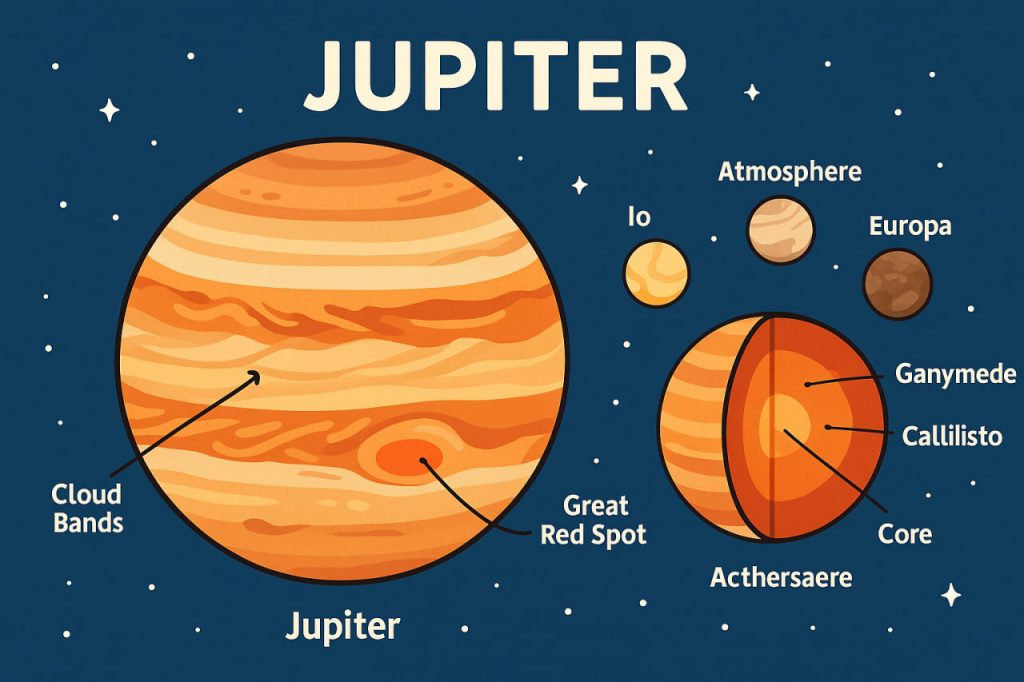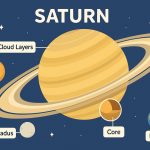Jupiter is the largest planet in our Solar System, more massive than all the other planets combined. Known for its swirling storms, colorful bands, and immense size, Jupiter is a gas giant that has fascinated astronomers for centuries. Its powerful gravity, numerous moons, and mysterious interior make it a crucial piece in understanding our cosmic neighborhood.
Basic Facts About Jupiter
- Distance from the Sun: ~778 million km (5.2 AU)
- Diameter: ~142,984 km (11 times wider than Earth)
- Mass: More than 300 times Earth’s mass
- Length of day: ~10 hours (shortest day in the Solar System)
- Length of year: ~12 Earth years
- Atmosphere: Hydrogen and helium, with traces of methane, ammonia, and water
- Moons: At least 95 known, including the famous Galilean moons
- Rings: Faint, composed of dust particles
Jupiter’s Appearance and Storms
Jupiter’s striped appearance comes from high-speed winds blowing in opposite directions in its atmosphere, creating light and dark bands called zones and belts.
The most iconic feature is the Great Red Spot, a massive storm larger than Earth, which has raged for at least 350 years. Jupiter also hosts smaller storms, lightning, and auroras at its poles due to its strong magnetic field.
Internal Structure
Though Jupiter lacks a solid surface, it likely has:
- Atmosphere: Thick layers of hydrogen and helium
- Metallic hydrogen layer: Where extreme pressure turns hydrogen into an electrically conductive fluid
- Rocky core: Possibly Earth-sized, but still under debate
Jupiter emits more heat than it receives from the Sun due to slow gravitational compression—a process called Kelvin–Helmholtz contraction.
Jupiter’s Moons
Jupiter has a complex moon system, including:
- Io: The most volcanically active body in the Solar System
- Europa: An icy world that may harbor a subsurface ocean—prime for life exploration
- Ganymede: The largest moon in the Solar System
- Callisto: Heavily cratered and ancient
These Galilean moons were discovered by Galileo in 1610 and are some of the most intriguing worlds in the Solar System.
Magnetic Field and Magnetosphere
Jupiter has the strongest magnetic field of all planets, creating a vast magnetosphere that traps charged particles and causes intense radiation. It’s so large it extends millions of kilometers into space and can even affect some of Jupiter’s moons.
Exploration of Jupiter
Major missions include:
- Pioneer 10 & 11 and Voyager 1 & 2 – Early flybys
- Galileo orbiter – Explored Jupiter and its moons in the 1990s
- Juno (2016–present) – NASA’s ongoing mission studying Jupiter’s interior, atmosphere, and magnetic field
Future missions like Europa Clipper will further investigate Jupiter’s moons, especially the potential for life beneath Europa’s icy crust.
Conclusion
Jupiter is a planet of extremes—largest in size, strongest magnetic field, most massive collection of moons. It plays a key role in shaping the Solar System and may even have helped protect Earth by deflecting comets and asteroids. Studying Jupiter reveals not only its mysteries but also clues about the formation of planetary systems everywhere.
Glossary
- Gas Giant: A large planet composed mostly of hydrogen and helium
- Great Red Spot: A massive, long-lived storm on Jupiter
- Magnetosphere: The area around a planet dominated by its magnetic field
- Galilean Moons: The four largest moons of Jupiter discovered by Galileo
- Metallic Hydrogen: A phase of hydrogen that behaves like a metal under high pressure


